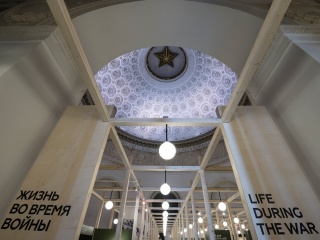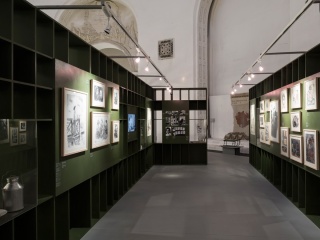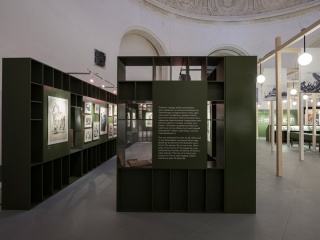The exhibition ’Fragments of peace.Life during the war’ was held in the Central Pavilion at VDNKH (state fair) and presented life in the Soviet Union during World War II. The exhibition was one of many events held to commemorate the 70th anniversary of WWII victory in Russia.
The central element of the exhibition was a wooden pergola dotted with round ’park’ lights, which aimed to create a nostalgic sense of the fragility of daily routine in the face of war. Passing through the ’alleyways’ the visitor encountered various objects whose form was suggestive of factory machinery, newsstands, shelves with children’s toys among other elements of the city and home.
The exhibition was divided among the pavilion halls into three distinctly themed parts.
The first hall recounted the departure of newly formed soldiers for the front lines, the work of the field post, and presented footage and audio material from the battlefront.
Private and public life in the city was explored in the second hall of the exhibition. The displayed material depicted how the appearance of cities changed, the art of camouflaging buildings and monuments, the creation of anti tank barricades and strategies that helped people survive bombings, as well as personal belongings and artwork that appeared during the war period.
The final part of the exhibition is dedicated to the great victory. The Soviet people were united in their faith in victory. Each and every one believed in it, and helped to bring it closer by whatever means they could. This hall presented footage of the victory parade of 1945, as well as victory themed paintings from the period.
Design: Olga Treivas, Vera Odyn, Elena Kornilova, Polina Dudkina, Natalya Zhernakova
Client: VDNH
Curator: Daria Makarova
Graphic design: Just design
Project Status: completed
Location: VDNKH , Moscow
Area: 1400 m2
Year: 2015
Photography: Yuri Palmin
The central element of the exhibition was a wooden pergola dotted with round ’park’ lights, which aimed to create a nostalgic sense of the fragility of daily routine in the face of war.
The first hall recounted the departure of newly formed soldiers for the front lines, the work of the field post, and presented footage and audio material from the battlefront.
Private and public life in the city was explored in the second hall.
The final part of the exhibition is dedicated to the great victory.

























